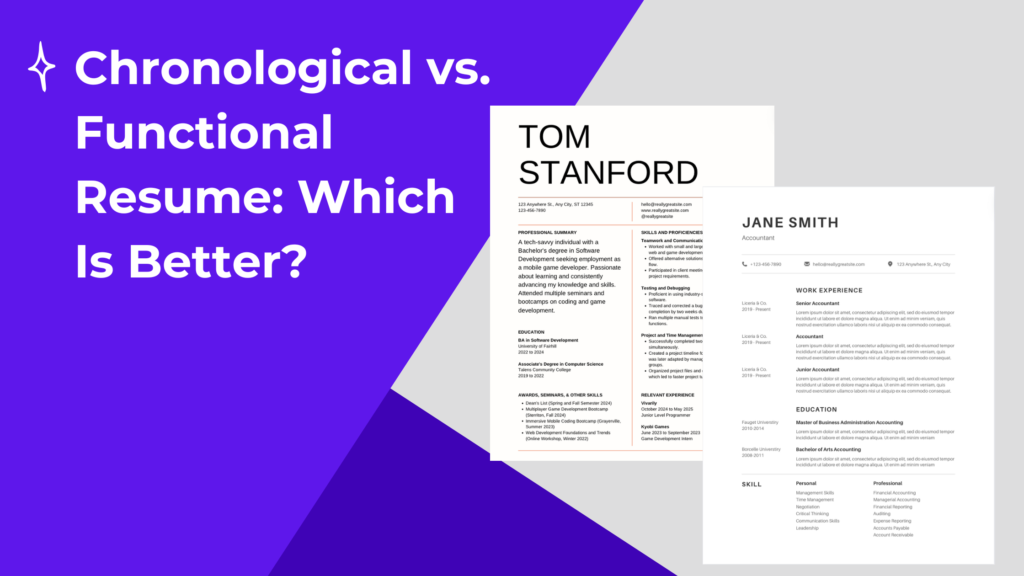When it comes to writing your resume, the format you chose can have a significant impact on how successful you are in presenting your professional story to potential employers. There are three commonly used formats for resumes, these are the chronological resume, the functional resume and the combination (or blended) resume. Different resume formats are used depending on an individual’s professional background, experiences, and career goals.
We’ll dive into the differences between these formats, to better understand their advantages and drawbacks, and help you determine which one is the right choice for your job search.
What is a Chronological Resume?
A chronological resume lists your work history in reverse chronological order, starting with your most recent job and working backward. It highlights your career progression, showing steady professional growth and relevant experience acquired over time. A chronological resume is ideal for someone with a consistent work history and clear career trajectory. It is the most commonly used resume format and often preferred by employers.
What are the advantages of a chronological resume?
Widely accepted: Chronological resumes are widely accepted across industries and sectors, making them a safe and familiar choice for job seekers. Employers, recruiters, and hiring managers are accustomed to reviewing resumes in this format, which enhances the likelihood of your resume being well-received and understood, increasing your chances of making a favorable impression on potential employers.
ATS friendly: Applicant Tracking Systems (ATS) are commonly used by employers to manage and filter incoming resumes. Chronological resumes are often ATS-friendly because they follow a straightforward format that is easily parsed by these systems. With clear headings and consistent organization, chronological resumes enable ATS to efficiently scan and process your work history, ensuring that your application is more likely to reach a human.
- Demonstrates career progression: A chronological resume presents your work history in reverse chronological order, allowing employers to see a clear and logical progression of your career. This makes it easy for them to understand your professional journey and assess your level of experience.
- Highlights stability: Employers often value stability and consistency in candidates. If you’ve had long tenures with previous employers, a chronological resume demonstrates your ability to hold positions for extended periods, indicating reliability, loyalty and commitment to your career.
- Showcases relevant experience: Recruiters and hiring managers are accustomed to reviewing resumes in this format, making it easier for them to navigate and quickly identify relevant experience for the position they’re hiring. With the most recent and relevant roles prominently displayed, they can assess your relevant qualifications more efficiently.
- Highlights achievements: With a chronological resume, you can easily incorporate specific achievements and milestones for each position you’ve held. This allows you to highlight your achievements and successes in previous roles, which can significantly enhance your candidacy.
What are the drawbacks of a chronological resume?
- Makes employment gaps obvious: A chronological resume prominently display your work history in reverse chronological order, making any gaps in employment more obvious. If you’ve had extended gaps between jobs, this can be apparent and may raise questions or concerns for employers.
- Not Great for Career Changes: If you’re changing careers, whether to a new role or new industry entirely, a chronological resume format may not effectively highlight your transferable skills and experiences related to the target position. It can be challenging to reframe your past roles to align with your new career direction, leading to potential mismatches between your qualifications and the job requirements.
- Less adaptive to Non-Linear Career Paths: If your career path has been non-linear or unconventional, with experiences that don’t follow a traditional path, a chronological resume format may struggle to effectively convey the coherence and relevance of your diverse background. This can be a disadvantage if you’re seeking to showcase your experience and skills in a structured manner.
- May Highlight Job Hopping: For candidates who have held multiple short-term positions, such as consultants or temps, a chronological resume format can emphasize job hopping or frequent changes in employment. This may raise concerns for employers regarding your stability, commitment, and suitability for long-term roles.
When should you use a Chronological resume
A chronological resume is the most commonly used format and is suitable for individuals with a consistent work history and a clear career progression. Here are some situations where a chronological resume may be the best choice:
- If you have a stable work history: A chronological resume allows you to showcase your steady career growth and demonstrate your commitment to previous employers.
- If you want to highlight your achievements: A chronological resume allows you to list your accomplishments under each job, giving employers a better understanding of your skills and abilities.
- If you have relevant experience in the same industry: A chronological resume is beneficial for individuals who have been working in the same field for several years as it shows their depth of knowledge and expertise.
- If you are applying for a job that requires specific technical skills: A chronological resume can be used to highlight your technical skills and experience in each role, which is important for certain industries or positions. Although you might want to also consider whether a resume or a CV is needed.
- If you have a solid career progression: A chronological resume allows employers to see how you have grown and advanced in your career, making it easier for them to assess your potential fit within their organization.
- If you have no employment gaps: A chronological resume is suitable for individuals with a consistent work history and no significant gaps in their employment, as it eliminates any potential red flags for employers.
Overall, a chronological resume is a popular and effective format that allows you to present your skills, experience, and achievements in a clear and organized manner. It is well-suited for individuals with a stable work history, relevant experience in the same industry, specific technical skills, solid career progression, no employment gaps, or a strong network/personal brand. However, it may not be the best choice for those with a varied work history or significant employment gaps, as it can highlight any inconsistencies.
What is a Functional Resume?
In contrast to the traditional timeline-based approach, a functional resume focuses on your skills and achievements rather than on specific job titles and previous employers. This unique format consists of sections like a qualifications summary, skills or areas of expertise, work experience (typically organized by skill categories rather than chronologically), education, and additional pertinent sections for certifications or achievements. It is commonly used by job seekers with employment gaps, career changers, individuals with diverse work experiences, or those looking to highlight specific skills and accomplishments.
What are the advantages of a Functional Resume?
- Highlights Transferable skills: Functional resumes are particularly useful for highlighting transferable skills that may not be directly related to a particular position or industry. For example, if you have strong communication and leadership skills gained through volunteer work or extracurricular activities, a functional resume allows you to showcase these abilities without being limited by job titles or past roles.
- Reduces focus on employment gaps: A functional resume can also help de-emphasize any employment gaps that may exist on your work history. Instead of focusing on the chronological timeline of your career, this format shifts the focus to your relevant skills and accomplishments, giving employers a better understanding of what you can bring to the table.
- Tailored to the job: Another advantage of a functional resume is its flexibility in tailoring your application to different job opportunities. By highlighting specific skills and achievements, you can easily customize your resume for each position, increasing your chances of landing an interview.
- Great for new grads: This format works great for recent graduates or individuals with limited past experience. The emphasis on your education, projects, and pertinent skills helps demonstrate your potential to employers. Adding experience with leadership roles in clubs, volunteer work, internships, and academic accomplishments can also help showcase your transferable skills such as teamwork and problem-solving. This type of resume bridges your academic and extracurricular experiences with the requirements of potential employers, making it easier for them to assess your potential.
- Useful for career changes: A functional resume is also beneficial for individuals looking to make a career change. If you are changing industry or field of work, a functional resume allows you to highlight your transferable skills and accomplishments that are relevant to the job. This can help mitigate any concerns employers may have about your lack of direct experience in the new field. In fact, a functional resume can help make a strong case for why you are the right fit for a particular position, despite not having traditional experience in that field or role.
What are the drawbacks of a functional resume?
- Difficult to assess work history: One of the potential downsides of this resume format is that recruiters may struggle to understand your career path due to the lack of a clear timeline. This may raise questions about your career stability and evolution.
- Not widely accepted: Functional resumes may be met with skepticism by more traditional employers who are not accustomed to this format. They might perceive it as an attempt to hide inconsistencies or employment gaps. As such, it is important to assess the potential employer and tailor your resume accordingly.
- Lack of specific details: Since a functional resume focuses on skills and accomplishments rather than job titles and responsibilities, it may not provide enough information for an employer to fully understand your previous roles. This lack of specificity could result in employers wanting more clarification or asking for additional information during interviews.
- ATS Compatibility Issue: Functional resumes face a major challenge with modern Applicant Tracking Systems (ATS). These systems are designed to analyze resumes in a chronological format, focusing on employment history with clear dates. Functional resumes, which prioritize skills over a linear work history, often lack the format needed for ATS algorithms to extract and categorize information accurately. As a result, this may lead to your resume being overlooked or receiving lower scores, reducing your chances of getting a shot at an interview – a significant disadvantage in a competitive job market where visibility is key.
When should you use a Functional Resume?
While there are various situations where a functional resume may be beneficial, it’s essential to understand when it’s most suitable.
- If you have employment gaps: A functional resume can help downplay gaps in your employment history by focusing on relevant skills and accomplishments.
- If you are changing careers: A functional resume is an excellent way to highlight transferable skills and showcase how they apply to the job you are targeting, even if they were acquired in a different industry.
- If you have a diverse work history: A functional resume can help tie together seemingly unrelated job experiences by emphasizing the skills and achievements gained in each role.
- If you want to stand out from the crowd: In some industries or positions, a functional resume may make you stand out as it highlights your unique abilities rather than just a traditional work history.
While functional resumes may have some benefits, it’s crucial to consider the potential drawbacks before deciding to use one. Some hiring managers may view functional resumes with suspicion as they can be seen as an attempt to hide gaps or lack of experience. Additionally, ATS algorithms may not be able to accurately extract information from a functional resume, reducing your chances of getting noticed by employers.
Overall, the key to any resume format is to effectively communicate your skills, experiences, and achievements clearly and concisely. Whichever format you choose, ensure it highlights your strengths and aligns with your career goals. Always proofread and tailor your resume for each job application to boost your chances of success. With the right format and content, your resume can stand out and help you secure your dream job. Careerpilot AI Resume Builder can help you craft a strong resume that showcases your qualifications and potential as a top candidate. Good luck!






